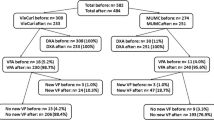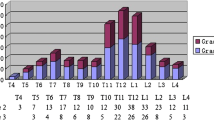Abstract
Summary
Many diabetic patients with vertebral fractures remain undiagnosed and untreated. We found that more than two-thirds of osteoporotic diabetic women could not be identified for pharmacological treatment according to the NOF guidelines if without radiographic vertebral assessment. This study shows the importance of radiographic vertebral assessment for identifying patients who need treatment for osteoporosis in diabetic women.
Introduction
Diagnosis of vertebral fracture (VF) is important for identifying patients who need pharmacologic therapy for osteoporosis. However, many patients with vertebral fractures remain undiagnosed and untreated. This study evaluated the number of patients with VFs who would be unrecognized as candidates for osteoporosis treatments according to the National Osteoporosis Foundation (NOF) Clinician’s Guidelines to the Treatment of Osteoporosis, among postmenopausal diabetic Korean women without spinal imaging.
Methods
A total of 873 postmenopausal diabetic women were enrolled. Lateral plain radiographs of the thoracolumbar spine and total hip BMD were obtained. The Fracture Risk Assessment Tool (FRAX®) probability was computed using the algorithm available online at http://www.shef.ac.uk/FRAX (South Korea version). The subjects with and without VFs were classified into candidates for osteoporosis treatment [Tx + by NOF] and not candidates for osteoporosis treatment [Tx − by NOF] according to the NOF pharmacologic treatment guidelines, regardless of the presence of VFs.
Results
Forty-six percent of postmenopausal diabetic women had morphometric VFs. Among the subjects with morphometric VFs, only 2% of the patients had previously diagnosed VFs by medical doctors. In addition, 73.6% of the patients with VFs were not included in the [Tx + by NOF] group, given the assumption of no radiographic diagnosis of VFs.
Conclusions
With regard to increased risk of VFs in postmenopausal Korean women with type 2 diabetes mellitus, radiographic vertebral assessment would be useful for the clinical identification of osteoporosis and fractures.



Similar content being viewed by others
References
OECD (2007) OECD economic survey Korea. OECD, Paris. 107–8
The Korea Institute for Health and Social Affairs and the Korea Centers for Disease Control and Prevention (2008) The fourth Korea National Health and Nutrition Examination Survey (KNHANES)
Melton LJ III, Kan SH, Frye MA et al (1989) Epidemiology of vertebral fractures in women. Am J Epidemiol 129:1000–1011
Meunier PJ, Delmas PD, Eastell R et al (1999) Diagnosis and management of osteoporosis in postmenopausal women: clinical guidelines. International Committee for Osteoporosis Clinical Guidelines. Clin Ther 21:1025–1044
Black DM, Arden NK, Palermo L et al (1999) Prevalent vertebral deformities predict hip fractures and new vertebral deformities but not wrist fractures. Study of Osteoporotic Fractures Research Group. J Bone Miner Res 14:821–828
The Korean Society of the Bone Metabolism (2008) Physician’s guide for diagnosis & treatment of osteoporosis. The Korean Society of the Bone Metabolism, Seoul
National Osteoporosis Foundation (2010) Clinician’s guide to prevent and treatment of osteoporosis. National Osteoporosis Foundation, Washington, DC
Greenspan SL, von Stetten E, Emond SK, Jones L, Parker RA (2001) Instant vertebral assessment: a noninvasive DXA technique to avoid misclassification and clinical mismanagement of osteoporosis. J Clin Densitom 4:373–80
Cauley JA, Thompson DE, Ensrud KC, Scott JC, Black D (2000) Risk of mortality following clinical fractures. Osteoporos Int 11:556–561
Gold DT (1996) The clinical impact of vertebral fractures: quality of life in women with osteoporosis. Bone 18(Suppl 3):185S–189S
Link TM, Guglielmi G, van Kuijk C, Adams JE (2005) Radiologic assessment of osteoporotic vertebral fractures: diagnostic and prognostic implications. Eur Radiol 15:1521–1532
Lewiecki EM, Laster AJ (2006) Clinical review: clinical applications of vertebral fracture assessment by dual-energy x-ray absorptiometry. J Clin Endocrinol Metab 91:4215–4222
Middleton ET, Steel SA (2008) Routine versus targeted vertebral fracture assessment for the detection of vertebral fractures. Osteoporos Int 19:1167–1173
Fink HA, Milavetz DL, Palermo L et al (2005) What proportion of incident radiographic vertebral deformities is clinically diagnosed and vice versa? J Bone Miner Res 20:1216–1222
Vokes TJ, Dixon LB, Favus MJ (2003) Clinical utility of dual-energy vertebral assessment (DVA). Osteoporos Int 14:871–878
Choi YJ, Kim HC, Kim HM et al (2009) Prevalence and management of diabetes in Korean adults: Korea national health and nutrition examination surveys. 1998–2005. Diabetes Care 32:2016–2020
Vestergaard P (2007) Discrepancies in bone mineral density and fracture risk in patients with type 1 and type 2 diabetes: a meta-analysis. Osteoporos Int 18:427–444
Janghorbani M, Van Dam RM, Willett WC, Hu FB (2007) Systematic review of type 1 and type 2 diabetes mellitus and risk of fracture. Am J Epidemiol 166:495–505
Yamamoto M, Yamaguchi T, Yamauchi M, Kaji H, Sugimoto T (2009) Diabetic patients have an increased risk of vertebral fractures independent of BMD or diabetic complications. J Bone Miner Res 24:702–709
Mehta JS, Reed MR, McVie JL, Sanderson PL (2004) Weight-bearing radiographs in thoracolumbar fractures: do they influence management? Spine (Phila Pa 1976) 29:564–7
Genant HK, Wu CY, van Kuijk C, Nevitt MC (1993) Vertebral fracture assessment using a semiquantitative technique. J Bone Miner Res 8:1137–1148
World Health Organization (2008) FRAX WHO fracture risk assessment tool. World Health Organization, Geneva
Gerdhem P, Isaksson A, Akesson K, Obrant KJ (2005) Increased bone density and decreased bone turnover, but no evident alteration of fracture susceptibility in elderly women with diabetes mellitus. Osteoporos Int 16:1506–1512
Schuit SCE, van der Klift M, Weel AEAM, de Laet CEDH, Burger H, Seeman E, Hofman A, Uitterlinden AG, van Leeuwen JPTM, Pols HAP (2004) Fracture incidence and association with bone mineral density in elderly men and women: the Rotterdam Study. Bone 34:195–202
Schwartz AV, Vittinghoff E, Bauer DC et al (2011) Association of BMD and FRAX score with risk of fracture in older adults with type 2 diabetes. JAMA 305:2184–2192
Donaldson MG, Cawthon PM, Lui LY et al (2009) Estimates of the proportion of older white women who would be recommended for pharmacologic treatment by the new U.S. National Osteoporosis Foundation Guidelines. J Bone Miner Res 24:675–80
Delmas PD, Genant HK, Crans GG, Stock JL, Wong M, Siris E, Adachi JD (2003) Severity of prevalent vertebral fractures and the risk of subsequent vertebral and nonvertebral fractures: results from the MORE trial. Bone 33:522–532
Schousboe JT, Vokes T, Broy SB et al (2008) Vertebral fracture assessment: the 2007 ISCD official positions. J Clin Densitom 11:92–108
Mithal A, Dhingra V, Lau E (2009) The Asian epidemiology, costs and burden of osteoporosis in Asia. International Osteoporosis Foundation, Nyon
Jiang G, Eastell R, Barrington NA, Ferrar L (2004) Comparison of methods for the visual identification of prevalent vertebral fracture in osteoporosis. Osteoporos Int 15:887–896
Hurxthal LM (1968) Measurement of anterior vertebral compressions and biconcave vertebrae. Am J Roentgenol Radium Ther Nucl Med 103:635–644
Hospers IC, van der Laan JG et al (2009) Vertebral fracture assessment in supine position: comparison by using conventional semiquantitative radiography and visual radiography. Radiology 251:822–828
Acknowledgements
We thank all the participants and research staffs in this multi-center study. We also thank Yoo Mee Kim (Mizmedi Hospital, Seoul, Korea) for the advice on quantitative morphometry. We acknowledge the data management support of the C&R research in the preparation of this manuscript. This work was supported by the Sanofi-Aventis Korea.
Conflicts of interest
None.
Author information
Authors and Affiliations
Corresponding author
Rights and permissions
About this article
Cite this article
Choi, Y.J., Yang, SO., Shin, C.S. et al. The importance of morphometric radiographic vertebral assessment for the detection of patients who need pharmacological treatment of osteoporosis among postmenopausal diabetic Korean women. Osteoporos Int 23, 2099–2105 (2012). https://doi.org/10.1007/s00198-011-1803-y
Received:
Accepted:
Published:
Issue Date:
DOI: https://doi.org/10.1007/s00198-011-1803-y




